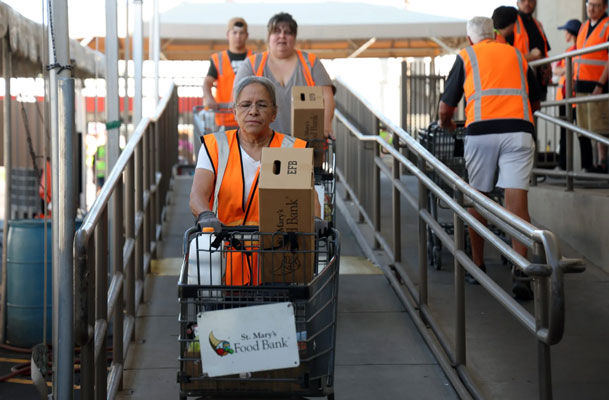By Isabella Gomez and Nick Karmia/Cronkite News
WASHINGTON – For people like Jeffrey Rajca, who runs the Canyon Family Church in Chinle, a small Navajo community in northeast Arizona, uncertainty about food stamps funding for November has meant anxiety over how he’ll afford groceries.
“I use the SNAP benefits to eat,” Rajca said. “That’s how I get my food.”
On Monday, the Trump administration said it will provide only enough funds to cover half the usual monthly payments for the nation’s 42 million food stamp recipients – and that much only because a court ordered it to do so.
The average monthly benefit is $181.83 per person in Arizona. So with only $90 and change coming his way, Rajca said, “I’ll probably just be eating Top Ramen.”
“That’s better than starving,” he added.
One in eight Americans relies on the Supplemental Nutrition Assistance Program. Arizona roughly tracks the national average, with 855,000 recipients in September, according to the Arizona Department of Economic Security.
But there are parts of the state that rely far more heavily on the federal food aid.
In Apache County – where Rajca has lived and worked for decades – nearly a third of individuals and 44% of households rely on SNAP, according to state data and census counts.
In Navajo and Yuma counties, a quarter of residents receive SNAP benefits.
In Santa Cruz and Gila, it’s more than one in five.
By comparison, 10% of Maricopa County residents receive SNAP.
In counties with especially high food insecurity, the potential loss of food aid this month – or even the loss of half the usual benefit – has struck fear.
“I don’t see why they can’t provide the full amount,” said Steve Knutson, director of the White Mountain Community Food Bank in Lakeside, 130 miles northeast of Phoenix near the Fort Apache Reservation.
He denounced the use of food aid as a “political football.”
“The food that we hand out is not going to be sufficient to meet their needs,” he said.
In the 60-year history of the food stamp program, benefits have never been interrupted during a budget standoff, including the 35-day shutdown halfway through President Donald Trump’s first term.
Before the shutdown that began Oct. 1, the U.S. Department of Agriculture promised to keep food aid flowing no matter what. But the USDA reversed itself ahead of the Nov. 1 monthly distribution of benefits, asserting that since Congress hadn’t approved its fiscal year 2026 budget, it had no choice.
Last Tuesday, Arizona joined two dozen other states in asking a federal court to force the USDA to tap a $6 billion SNAP contingency fund. The administration refused until it was ordered to do so on Friday by federal judges in Rhode Island and Massachusetts.
The USDA told a court Monday that it had already spent some of the contingency fund, and will provide $4.65 billion to states – enough “to cover 50% of eligible households’ current allotments” for November but not for any new applicants.
The USDA refused to tap a separate, much bigger reserve fund supported by fees on imports, arguing that doing so would take funding away from the school lunch program that serves 29 million children and other childhood nutrition programs.
Rajca has long relied on a mix of Medicaid, church donations, and SNAP to make ends meet. For decades, he has maintained the mission site his parents founded in the 1990s. He also runs a children’s program through his church.
Without a full monthly SNAP allotment, he plans to tap into donations he would rather use for his ministry.
“If they have to feed me at $300 a month, that means that’s probably $300 that doesn’t go for the kids program,” he said. “So I’m going to try and cut back as much as I can so I don’t steal all the money from the kids.”
East of Phoenix, floods last month washed out roads and destroyed homes in Globe and nearby communities.
The SNAP crisis has made the suffering worse, said Roberta Loyd, who has volunteered at the Gila Community Food Bank in Globe for 14 years.
“If people can get here, we are feeding them,” she said.
Since Monday morning, she said, the bank has been “slammed.”
Ahead of the Nov. 1 funding cliff, governors in both parties scrambled to make up the shortfall and avert widespread hunger.
In Virginia, with a SNAP roll about the same as Arizona’s, Gov. Glenn Youngkin said the state was prepared to spend about $37 million this month on SNAP benefits. Another Republican, Louisiana Gov. Jeff Landry, said he would find the $150 million his state’s recipients would need.
In California and New York, Democratic Govs. Gavin Newsom and Kathy Hochul said they would set aside $80 million and $62 million, respectively.
In Arizona, Gov. Katie Hobbs announced $1.8 million in emergency state aid, mostly to help food banks statewide. She conceded that it was only a “drop in the bucket” compared to Arizonans’ needs.
The governor’s plan includes $300,000 to cover $30 food vouchers for 10,000 people.
At that level of state support, said Punam Ohri-Vachaspati, a professor of nutrition who leads the Arizona State University Food Policy and Environment Research Group, “People will have to go without meals, and food insecurity rates will increase extensively” until full federal payments resume.
Adrienne Udarbe, executive director of Pinnacle Prevention, an Arizona nonprofit group that works to reduce food insecurity, said USDA funds could hit recipients’ debit cards early next week.
“Those contingency funds should have been activated to prevent this from even happening to begin with,” she said. “Luckily, the court ruling has cleared that up, so I hope we don’t see a repeat in a future shutdown.”
For more stories from Cronkite News, visit cronkitenews.azpbs.org.









